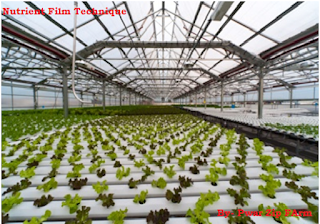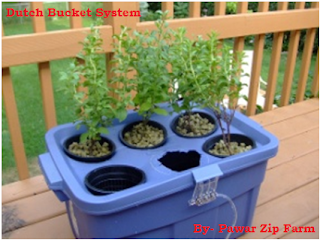What is hydroponics?
Hydroponics is a technology for growing plants in nutrient solutions (water containing fertilizers) with or without the use of an artificial medium (sand, gravel, vermiculite, Rockwool, perlite, peat moss. coir, or sawdust) to provide mechanical support. As seen in the picture, irrigation pipes carrying nutrient solutions (water containing fertilizers). Also, notice the plastic containers containing artificial medium to provide mechanical support Liquid hydroponic systems have no other supporting medium for the plant roots: aggregate systems have a solid medium of support. Hydroponic systems are further categorized as open (i.e. once the nutrient solution is delivered to the plant roots, it is not reused) or closed (i.e. surplus solution is recovered, replenished, and recycled). Hydroponic growing (as opposed to soil growing) allows you to control the nutrient levels for your plants directly. Because of the higher control over nutrients, hydroponically grown plants generally have a much higher yield than similar plants grown in soil.
Hydroponics growing
A plant gets its food source by turning Co2, light, and water (or hydrogen) into carbohydrates through a process called photosynthesis. With hydroponics growing, plants are grown without soil so they must get their nutrients from the nutrient solutions added to water. The absence of soil in growing means that hydroponics systems must have some way of supporting the plants while still allowing the bare root system maximum exposure to the nutrient solution. Often a “growing medium” is used for support and to aid in moisture and nutrient retention in hydroponics growing. Because they lack media to store water and nutrients, water culture systems need a continuous flow of nutrients to prevent drying out the plant roots. Plants need an energy source in order to grow. With hydroponics growing this energy may come from natural light, which has the full spectrum of color or through the use of different types of artificial lighting (grow lights), which can be selected for specific plant varieties and optimum plant growth characteristics.
What do you need to start hydroponic production?
Garden production unit
Source of clean water
The right location
Specially formulated fertilizer
Time to attend to the system daily
A little knowledge of plants or gardening
A commercial or homemade unit
Commercial production unit
Water is the most important consideration, that is in terms of quality, quantity, and reliability.
Market. Know what, where and when to market your crop.
Hydroponics is labor intensive. During peak season, labor must be available for 7 days a week.
Management skills: Production, labor, marketing, and infrastructure.
Expertise in crop production, fertilisation and irrigation, pests and disease management.
Location: Infra-structure, labor, market, etc.
Financing: The amount needed depends on the size, type of greenhouse, labor cost and your market.
Dedication: labor and management in general.
With garden production unit, the source of energy derived from natural light whereas with the commercial production unit, the source of energy derived from artificial lighting (grow lights).
• Water flow must be checked every day and adjusted when necessary.
• If plants turn yellow, it is normally a symptom of nutrient deficiency, too little light or a disease.
• Inspect the leaves every day for disease symptoms and insects. Act immediately if a problem occurs.
• Tall plants need to be trained and pruned to make optimal use of the expensive greenhouse space.
Plants are irrigated automatically.
No water stress.
Nutrients are available at all times
Only soluble fertilizers are used.
Hydroponic fertilizer formulations contain a balanced nutrient content.
Soil-borne diseases can be eliminated
Good soil = good drainage, compost, disease-free.
Plants need to be irrigated to minimize water stress.
Nutrients must be added to the soil.
Unless a laboratory analysis is done, too much or too little nutrients can be added.
Soil-borne diseases can build up in the soil.
Hydroponic production is not organic because artificial nutrients are always used and plants are usually not grown in soil.
It is possible to produce organic vegetables in soil because one can use organic fertilizers such as compost and manure.
Aeroponics
Excellent for starting large crops of seedlings, transplants, and cuttings or growing plants or crops to full maturity, this system sprays the roots with nutrient-rich water.
Aquaponic
In this system, plants are watered from the fish tank. Most of the nutrients for plants are taken by the fish tank as it has west from fish.
Passive system
Great for home or office this system can grow any type of vegetative, flowering or fruiting plant. The plant determines when it needs water and nutrients. Relatively simple to operate and very easy to maintain, hydroponics systems provide the right conditions allowing plants to grow between two and four times faster than those in the soil.
Basics of hydroponics
To be able to produce vegetables successfully year after year, one needs to be familiar with the basics of hydroponics in term of the plant, growing medium, water, and nutrients.Which crops can be grown in hydroponics?
Basically, all high-value crops can be grown. Popular in South Africa are tomatoes, cucumbers and peppers in a drain to waste systems and lettuce and herbs in gravel flow systems.Where can you buy seeds?
Seeds are available in small or large packages. Small packets are sold at nurseries, co-ops, and retail stores and are suitable for garden and small-scale hydroponic units. Large packets, suitable for commercial scale production are available from seed companies.Taking care of plants
Different crops are planted at different spacing. Small-growing plants can be planted close to each other. Large-growing plants need more space to grow and must be spaced further apart.• Water flow must be checked every day and adjusted when necessary.
• If plants turn yellow, it is normally a symptom of nutrient deficiency, too little light or a disease.
• Inspect the leaves every day for disease symptoms and insects. Act immediately if a problem occurs.
• Tall plants need to be trained and pruned to make optimal use of the expensive greenhouse space.
Differences between hydroponic vegetable production and Soil production.
Hydroponic
No soil is required. Plants are irrigated automatically.
No water stress.
Nutrients are available at all times
Only soluble fertilizers are used.
Hydroponic fertilizer formulations contain a balanced nutrient content.
Soil-borne diseases can be eliminated
Field production.
Good topsoil is required. Good soil = good drainage, compost, disease-free.
Plants need to be irrigated to minimize water stress.
Nutrients must be added to the soil.
Unless a laboratory analysis is done, too much or too little nutrients can be added.
Soil-borne diseases can build up in the soil.
Hydroponic production is not organic because artificial nutrients are always used and plants are usually not grown in soil.
It is possible to produce organic vegetables in soil because one can use organic fertilizers such as compost and manure.
Hydroponics systems
Using hydroponics systems, mineral nutrients are dissolved in water and feed directly to a plant’s root system allowing the plants to focus their energy into growing mostly upward, promoting quicker growth, faster harvests, and higher yields. Hydroponics systems are used year-round both indoors and outdoors for growing herbs, foliage, and food items. Hydroponics setup does not use soil but instead, use an inert growing medium to anchor a plant’s roots.The different types of hydroponics systems available include nutrient film technique NFT, drip watering, aeroponics, Ebb and flow, deep water culture DWC, Dutch bucket system, aquaponic and passive systems.
Nutrient film
Hydroponics gardening utilizing an oxygen-rich nutrient solution is an ideal system for a wide range of crops including lettuce, strawberries, herbs, flowers, tomatoes, peppers, eggplant, squash, and cucumbers. Drip watering Popular with small commercial hydroponics growing operations, hobbyists and schools this system is designed to grow tomatoes, cucumbers, peppers, herbs and flower crops.Aeroponics
Excellent for starting large crops of seedlings, transplants, and cuttings or growing plants or crops to full maturity, this system sprays the roots with nutrient-rich water.
Ebb and flow
Popular for rooting cuttings, germinating seedlings and vegetating young plants which are fed automatically with a simple flood and drain watering method.Deep water culture
This system is used to produce most vegetative plants like lettuce in which roots are deep into nutrient water. In this system, plants don't need to get water every time.Dutch bucket system
In this system, plants are grown in the bucket full with clay pallets in it with watering it once a day.Aquaponic
In this system, plants are watered from the fish tank. Most of the nutrients for plants are taken by the fish tank as it has west from fish.
Passive system
Great for home or office this system can grow any type of vegetative, flowering or fruiting plant. The plant determines when it needs water and nutrients. Relatively simple to operate and very easy to maintain, hydroponics systems provide the right conditions allowing plants to grow between two and four times faster than those in the soil.





No comments:
New comments are not allowed.